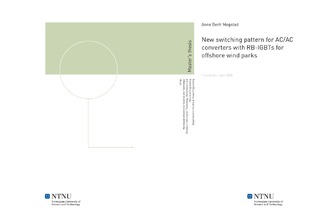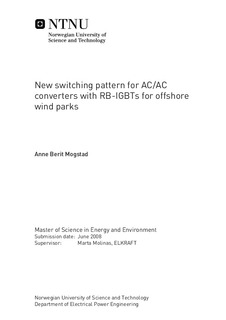| dc.contributor.advisor | Molinas, Marta | nb_NO |
| dc.contributor.author | Mogstad, Anne Berit | nb_NO |
| dc.date.accessioned | 2014-12-19T13:51:11Z | |
| dc.date.available | 2014-12-19T13:51:11Z | |
| dc.date.created | 2010-09-04 | nb_NO |
| dc.date.issued | 2008 | nb_NO |
| dc.identifier | 348660 | nb_NO |
| dc.identifier | ntnudaim:4184 | nb_NO |
| dc.identifier.uri | http://hdl.handle.net/11250/256591 | |
| dc.description.abstract | Offshore wind power has an increasing interest in the research community and among the politicians. Therefore it is important to find the right solutions to meet the environmental and commercial requirements to give offshore wind power a promising future. This thesis are proposing a new converter topology for offshore wind parks. Since the topology is based on DC transmission in stead of AC transmission it is better suited for use in this type of parks. All the converters are located in the wind turbines and the turbines are connected in series directly connected to shore without any transformation stages. The one-phase AC to three-phase AC converter with the new switching pattern is explained and a method to calculate the losses in the converter is given. The loss calculation method is based on the characteristics of the switch found in the data sheet, which in this case is a RB-IGBT. The conduction losses, turn-on, turn-off and recovery losses for one switch are calculated and multiplied with the number of switches in the converter. An equation of the total losses per switch is given and there are performed loss simulations for the converter in PSCAD with good results. In the AC-AC converter there are bidirectional switches, in this case two reverse-blocking IGBTs. The RB-IGBT is compared to other types of bidirectional switches which is made of IGBTs and diodes in anti parallel. The comparison shows that with the RB-IGBTs the on-state voltage drop is halved since a RB-IGBT has the same on-state voltage drop as a normal IGBT. This also reduces the on-state losses. The architecture of the RB-IGBT is almost the same as the IGBT but with an extension of the p+ layer on the edges up to the gate isolation. This separates the sides from the active region of the chip so the leakage currents from the side surfaces of the device are blocked. A design of a high power high frequency transformer for the converter topology in the nacelle of the wind turbine is proposed. A design method is used and a program to calculate the necessary values is made. The transformer should be a double E-core with a centre leg of 4.5 cm made of the ferrite material N27. Both primary and secondary windings, which will be copper foils, should be wound on the centre leg of the core using a bobbin. The primary windings will be separated in two sections each section having 12 layers with two turns per layer. The secondary windings will be sandwiched between the primary sections and will consist of 24 layers with two turns per layers. Each foil conductor has a height of 4.5 cm and a thickness of 0.3165 mm. The new converter topology reduces the converter losses due to fewer converter stages, a new type of reverse-blocking IGBT and a new switching pattern. It also reduces the weight of the converter system because of no capacitors and a lighter transformer. This is important for floating wind turbines. A prototype of the converter topology with protection should be made to verify the results of this thesis. Simulation studies for the whole park during operation and faults should also be carried out to see if the topology fits the harsh conditions offshore. | nb_NO |
| dc.language | eng | nb_NO |
| dc.publisher | Institutt for elkraftteknikk | nb_NO |
| dc.subject | ntnudaim | no_NO |
| dc.subject | SIE5 energi og miljø | no_NO |
| dc.subject | Elektrisk energiteknikk | no_NO |
| dc.title | New switching pattern for AC/AC converters with RB-IGBTs for offshore wind parks | nb_NO |
| dc.type | Master thesis | nb_NO |
| dc.source.pagenumber | 101 | nb_NO |
| dc.contributor.department | Norges teknisk-naturvitenskapelige universitet, Fakultet for informasjonsteknologi, matematikk og elektroteknikk, Institutt for elkraftteknikk | nb_NO |

